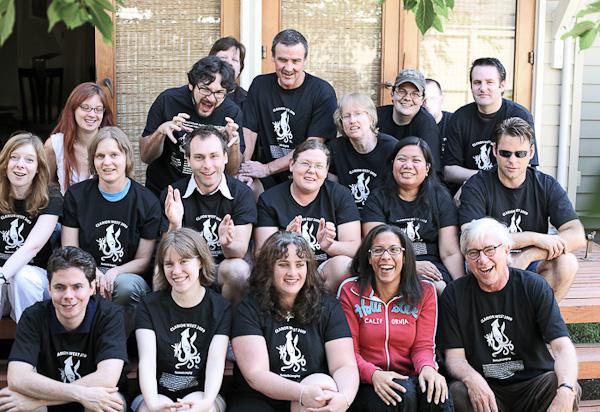Collected Essays (14 page)
Authors: Rudy Rucker

This talk was for a San Francisco conference on the future of sex. I found it hard to cook up a really long essay on the theory of this topic, so I fattened up my presentation with excerpts from my fiction. Show, don’t tell.
Chant to the Muse
Time, saucers, sex and goo
Elves, mutants, robots too
Muse of strangeness old and new
My blank pages call to you.
Note on “Chant to the Muse”
Written July, 2009.
Published on
Rudy's Blog
, 2009.

With my Clarion students, July, 2009.
I wrote this little chant for my students at a Clarion SF Writing Workshop in Seattle. They’d had a series of SF writers talking to them, and I was the last instructor. So on the very last day of class, I got my students to come down into an echoing basement room with me, and we chanted these four lines for about fifteen minutes, repeating them over and over. It was fun.
Part 2: SILICON VALLEY
Welcome to Silicon Valley
In 1986, it became unfeasible for me to continue living as an unemployed cyberpunk writer in Lynchburg, Virginia. I was broke and getting deeper into debt, while our children were needing braces and college. Even if it was peaceful and cozy in Lynchburg, the bandwidth always seemed way too low—where the “bandwidth” of some information source means the number of bits per second that it delivers.
What was really chafing on me the most was my strong sense that I was missing out on a great intellectual revolution: the dawn of computer-aided experimental mathematics. Fractals, chaotic iterations, cellular automata—it was everywhere. I clicked over the final switchpoint when I went as a journalist to Princeton and to Cambridge, Massachusetts, to interview computer scientists for an article about cellular automata. Those guys were having so much fun, looking at such neat things, and making up such great theories about what they saw! I decided to become one of them.
If you’re a mathematician, becoming a computer scientist is not so much a matter of new knowledge as a matter of new attitude. Born again. Willing to commit to the machine. By way of preparation, I wrote
Mind Tools
, a book which surveys mathematics from the standpoint that everything is information. So when I got the chance to interview for a job in the Department of Mathematics and Computer Science at San Jose State University, I had thought enough about computers to give a good talk on information theory. They hired me and I started teaching there in the Fall of 1986.
Most people in the East don’t know where San Jose is. Put your right hand so the palm faces down. Think of the left edge of your arm as the coast of California. San Francisco is the tip of your thumb. The space between thumb and forefinger is San Francisco Bay. The thumb’s first knuckle is Palo Alto. San Jose is at the bottom of your thumb, near the bay. Silicon Valley is the thumb’s second joint, between San Jose and Palo Alto. There’re a lot of roads and a lot of traffic. And for the first seven years I lived there, it never rained.
One of the courses I had to teach in my first semester at SJSU was Assembly Language. Assembly language is a very stark and simple language—a bit like Basic—with about a hundred elementary commands. What makes assembly language tricky is that in order to use it properly, you need to have a very clear image of what is going on inside the specific family of machines you are writing for (our course is for PC clones). You have to interact with the machine a little before you can get an assembly language program to run. I got the textbook: Dan Rollins,
8088 Macro Assembler Programming
, and I couldn’t understand what it was about at all. The only computer I’d used at this point was an Epson machine I bought for word-processing. I didn’t know that 8088 was the name of a processor made by Intel. I didn’t know that you say it “eighty-eighty-eight” and not “eight-thousand-and-eighty-eight” or “eight-oh-eight-eight.” If I were the type to panic, I would have done so.
Fortunately, there was another mathematician-turned-computer scientist at SJSU who was teaching Assembly Language, and his class met the period before me mine. I went to his classes and wrote down everything he said, and then I would teach that to my class. I enjoyed sitting in his class like a student again, soaking up info for free. The only thing about his class I didn’t like was this jerk who sat in front of me, a guy named Farley.
Farley was fat and petulant. His upper lip stuck out like on the man in that crummy Sunday funnies cartoon, “The Lockhorns,” if you’ve ever seen it. Farley would get into big arguments with the teacher about arcane features of assembly language. He would interrupt without even raising his hand. And after class he was always trying to cozy up to the girls. Remember Farley; I’ll come back to him at the end.
I could never get enough time on the machines at school to do the assembly language homework, so after the first semester I went and bought the then-maximum personal computer—it had a twelve megahertz processor, a forty megabyte hard disk, and a sixteen-color graphics card. Some of my friends on the faculty were real computer jocks, and they helped me get psyched up for it. One professor in particular liked to say, “Computers are to the ‘80s what LSD was to the ‘60s.”
The first program I ran was a Mandelbrot set program that a fan had sent me. The Mandelbrot set is a fantastically complex pattern that arises from applying a lot of computing power to a very simple rule having to do with repeatedly taking the square of a complex number. It looks a bit like a black beetle with a long stinger on one end. You can use a computer to endlessly zoom in on its details, and the remarkable thing is that there are endless levels of detail to examine. Just like the irrational decimal number
pi
, the Mandelbrot set goes on forever, to as many levels of magnification as your computer can examine.

The Mandelbrot set.
I was so happy watching the colored little dots of my Mandelbrot zooms accumulate. I didn’t know any other programs yet, but I could make this one look different by screwing with the monitor controls. If you messed up the vertical hold and set the monitor to analog instead of digital mode, for instance, the picture looked sort of like Antarctica, with more and more new little pixels moving in, men in boats, penguins, real deep info being born.
The next program I played with a lot was SF-writer-and-computer-hacker Charles Platt’s “Cell Systems” program for showing cellular automata. Charles and I went to a CA (cellular automata) conference together at MIT right before I came to SJSU. I liked to look at Charles’s program all the time; in the morning or at night, especially at night.

A cascading cellular automaton rule called “Tree”.
Cellular automata came to seem rich enough to symbolize everything: society, the brain, physics, whatever. The whole thing with a cellular automaton is that you have a tiny tiny program that is obeyed by each pixel or screen cell. With each tick of the system clock, the cells all look at their nearest neighbors and use the tiny program to decide what to do next. Incredibly rich patterns arise: tapestries, spacetime diagrams, bubble chamber photos, mandalas, you name it. Each pattern is a screenful of info, about 100,000 bits, but the pattern is specified by a very short rule, sometimes as short as eight bits. The “extra” information comes from time flow, from the runtime invested, from the logical depth of the computation actually done. The same thing is true for the Mandelbrot set, by the way.
That next semester—this would be the spring of ‘87—I taught assembly language again, plus an advanced course in Pascal. With Pascal I couldn’t find a teacher to copy, so it was pretty grim. I spent a lot a lot a lot of time trying to get my programs to work, or at least trying to figure out what I could lecture on the next day. Assembly language was starting to be fun, though. Making it up as I went along, I showed my class how to write a program to show simple cellular automata, and it worked, and we were all really happy. One of my programs made a pattern that looked like elephants and giraffes. Shirley Temple used to sing “Animal Crackers in my Soup,” and in
Gravity’s Rainbow
, Pynchon has someone call that song “Super Animals In My Crack.” That was a joke that my new pattern made me think of. I bought a 24-pin dot matrix printer so I could start saving the pictures I made.
In the summer of ‘87, I persuaded SJSU to buy me a CAM-6 “cellular automaton machine.” This was a chip-laden card you could plug into a slot in any DOS-based personal computer. It had the effect of making my computer screen become a window into incredible new worlds. The CAM-6 made patterns that looked alive. And fast? Imagine globs of oil oozing around on your screen like a light show. Sixty updates a second!

A cellular automaton rule called “Ranch.”
So in the fall of ‘87, I was ready to go to some computer conferences. I went to the first workshop on Artificial Life, in Los Alamos, not quite sure what it was. Artificial Life turned out to be such a great concept. I mean, forget Artificial Intelligence, let’s do Artificial Life. Simple programs that grow and get more interesting as time goes on. Programs that eat computational energy! It was great at the Los Alamos conference. It was the first time I’d ever felt comfortable at an academic conference. We were all interested in the same thing: evolving artificially alive systems. And it was exactly what I’d been writing about in my SF novels
Software
and
Wetware
. Really happening at a government lab!
The town of Los Alamos is very weird, like a Twilight Zone movie set. They have a little museum with full-scale white-painted models of Little Boy and Fat Man. It made me just a little anxious why the government would be interested in Artificial Life. But I’ll trust those artificially alive robots of the future to get free—just like the boppers in
Software
.
Even more fun than the A-Life workshop was a meeting I went to a month later, something called
Hackers 3.0
, the third of a presumably annual meeting of Silicon Valley hackers. I should note here that “hackers” was being used in the older sense of “someone who loves to do things with computers, and not in the newer sense of “computer criminal”.
